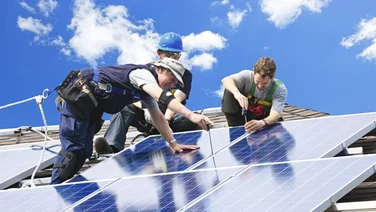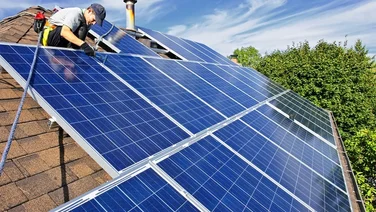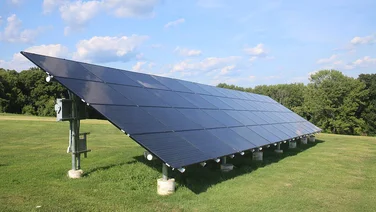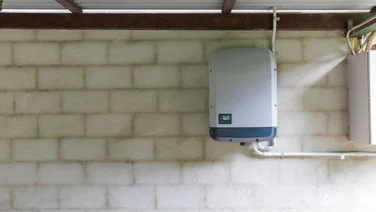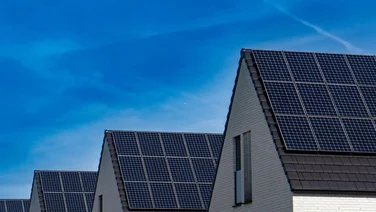✔ Solar panels in space can generate electricity at a near-constant rate
✔ Space-based solar works by beaming electricity from space back to Earth
✔ Solar panels in space degrade up to eight times faster
Solar is one of our best renewable options, and new solar technologies and innovations are constantly developing, meaning its popularity will only increase. But the panels themselves take up a lot of room on Earth — so what if we could generate more solar power in space?
It’s not as new a thought as you might think — the idea was first put forward in 1968 by pioneering space scientist Peter Glaser.
We’ve looked into whether it’s possible, whether there are already solar panels in space, and what the pros and cons of space-based solar panels are.
Where do you want to install solar panels?
Get started
Are there solar panels in space?
Solar panels are already in space, but are limited to a handful of satellites and the International Space Station (ISS).
There are no space-based solar panels capable of sending electricity to Earth, because the technology needed to make it possible hasn’t reached the point where it’s worth it.
The idea is sound, but the sheer cost of the solar project and lack of sufficiently precise equipment would make it a colossal waste of time and resources.
Are any countries planning to put solar panels in space?
The UK government published a report in 2021 detailing the logistics of solar panels in space, concluding that it’s a feasible way to generate electricity in future. It also commissioned new research into space-based solar power in 2020, showing the government’s appetite for this method of power generation.
George Freeman, the former UK science minister, said in 2022 that a £16 billion proposal to build a solar power station was being taken seriously by the government.
And, in June 2023, the government announced £4.3 million in funding for universities and technology companies to drive innovation in space-based solar.
Other countries investigating the possibility are China and the US, who both have dedicated programmes for space-based solar power.
China already has a roadmap for space-based solar power, and has claimed that by 2030, it’ll generate one megawatt hour from the technology. That’s 24 megawatt hours (MWh) per day in space, and 8,760 MWh each year — enough to power 3,020 UK households annually.
By 2050, China aims to have the first fully functional space-based solar plant.
Japan, India, and Russia are the other major players exploring solar panels in space.
Where do you want to install solar panels?
Get startedDo solar panels work better in space?
Solar panels are far more effective in space than on Earth because they can take advantage of near-constant light from the sun.
Space has no night and day cycles, so solar panels only spend a maximum of 72 minutes in the Earth’s shadow, and even that long is unusual.
That means they can generate electricity for 99% of the year, without any of the hurdles solar panels face on Earth: no clouds, no extreme temperatures reducing efficiency, and no dust.
Even on a clear, sunny day, solar panels on Earth can lose up to 55% of solar energy through the planet’s atmosphere. Space has no atmosphere, so solar panels in orbit receive unfiltered sunlight.
A problem for solar panels in space is that they degrade up to eight times faster than solar panels on Earth, owing to factors like high-energy particles and space debris.
The main material used for solar panels in space is different too — it’s gallium arsenide, instead of silicon. This material has a 34% efficiency rating, compared to the typical 18–23% rating of the most efficient silicon-based panels.
However, gallium arsenide is much more difficult to source than silicon. Estimated concentrations of gallium arsenide in the earth’s crust are just 17 parts per million — or 0.0017%.
In comparison, silicon makes up a whopping 27.7% of the Earth’s crust and is far cheaper as a result.
Because gallium arsenide is so rare it’s almost certain that silicon will make up the bulk of space-based solar panels.

How can space-based solar panels provide power on Earth?
Space-based solar panels can provide electricity to people on Earth by directly beaming energy to power stations on the ground.
That sounds like science fiction, but it’s exactly how it’ll work — though we haven’t yet settled on a single solution.
One concept would see giant mirrors directing as much sunlight as possible onto space-based solar panels.
The solar panels would convert the sunlight into electricity, which would then be shot back to a specially designed power station on the surface of the Earth as either a laser or microwave beam.
This power station will immediately distribute electricity as it’s received from space, and use a series of high-capacity solar batteries to store excess energy to be used later.
It’s a method that in June 2023, was apparently proven by the California Institute of Technology (Caltech). Caltech claimed to have beamed electricity from solar panels to the Earth for the first time, using the aforementioned microwave beam.
A receiver on the roof of the building on Caltech’s campus in Pasadena detected power, although Caltech did not disclose how much power had been transmitted from space.
Pros and cons of solar panels in space
- Much more efficient than terrestrial solar panels
- Can generate continuous electricity
- Space-based solar panels produce zero emissions
- Electricity can be quickly directed at different places on Earth, depending on where it’s needed
- It’s very expensive — it costs £7,716 to send a single kilogram into orbit
- Beaming power to Earth is logistically challenging
- Maintenance in space is very difficult
- Solar panels in space suffer around eight times the degradation of solar panels on Earth
What’s the future of space-based solar power?
Space-based solar power will work, and when scaled up, it’ll provide us with almost unlimited energy.
However, it’s also incredibly challenging. Manufacturers must make big leaps in reducing the weight of solar panels, so sending them to space isn’t as expensive. Advancements in thin-film solar panels will help with this.
Satellite stability is a tricky issue as well, as we aren’t yet capable of maintaining a precise-enough beam to guarantee consistent power. If space-based solar power is to be a genuine solution, we can’t have a beam that wobbles.
Building the infrastructure in space is also a huge challenge, though creative minds are already thinking outside the box with ideas like 3D printing solar cells onto giant, foldable solar sails.
You could theoretically create solar power plants entirely in space, using a 3D printer aboard the ISS for example.
But even then, it’s a question of whether we have the time to develop the technology before the impacts of climate change become too great.
We may be better off working on solutions that don’t require building incredibly complex structures in space, especially with the sky-high emissions involved in flying rockets.
It’s also possible to provide the world with enough energy from renewable sources on Earth. Data from the US government shows that using just 22,000 square miles for solar panels, about the size of Lake Michigan, would generate enough electricity for the entire US.
The Eco Experts’ research showing what a 100% renewable UK would look like found that using just 6.2% of the country’s marine territory for wind power would provide enough energy for its population.
Around three quarters of the UK thinks we are in a climate emergency, according to our latest National Home Energy Survey.
Summary
Space-based solar power is an exciting concept and one that could answer a lot of our energy problems on Earth.
The main barriers are currently cost and feasibility, because building the infrastructure on the ground is difficult enough, let alone putting it in space.
Time is not on our side either — the climate crisis has pushed the need to rapidly develop green solutions to the forefront, and space-based solar power at the scale we need is decades away.
We should instead focus on ending our reliance on fossil fuels and continuing to expand the number of renewable energy sources we use.


